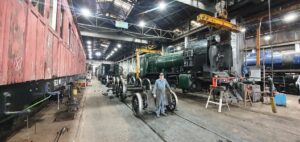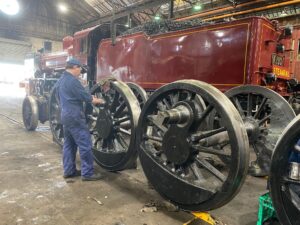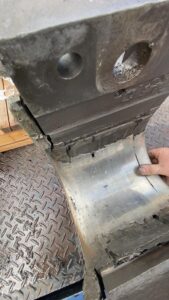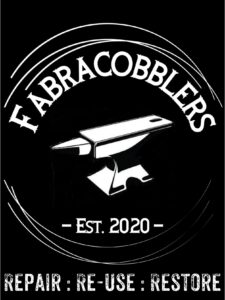Keep K163 Going
Axleboxes
Part 1 – Axleboxes Assessments
A major aspect of the Keep K163 Going project is lifting the engine off of it’s wheelsets to assess the condition of journals and axleboxes.
K163 was restored for preservation back in 1986 and has operated for the Mornington Railway reliably for many years. However during this original restoration the engine was not lifted. To do so is a large undertaking for a small Preservation Society which would come at great cost if reliant on mobile crane hire considering the engine itself weighs at least 40tons (empty). Thanks to our friends at Steamrail Victoria an opportunity presented to utilise the facilities at the Newport West Block facility for this purpose.
Above: Mechanical Engineering Manager, Bernd Bukolt standing proudly beside disassembled K163 at Newport.
With the engine lifted, attention turned to assessment of the journals. Luckily it was determined the journals were within specification in relation to the relevant Victorian Railway Practice Cards. This was a significant project stage gate. If repairs were required to the journals specialist heavy engineering services would have been required to grind the journals (similar to the work that was required for the crank pins). This step had the potential to add additional expense and time to the project.
Above: Measuring the crank pins with the micrometers
Once the journals were ticked off, the next step was to assess the condition of axleboxes. Leading up to the project we were aware we had issues with lateral clearances and crown roll (the famous K class knock) however the detailed condition of the bearings were unknown. The K class design involves plain bearings which are bronze lined with whitemetal. Whitemetal is a special lead/tin based alloy that is commonly used in this application.
The first issue that was identified with the axleboxes once available for inspection was that both the Left and Right Driving position bearings were loose within the axleboxes. Normally these are an interference fit and retaining dowels also keep these captive.
Secondly it was evident very quickly that most of the hub liners (also whitemetal) were disconnected from the axlebox/bearing and required complete replacement.
Above: RD axlebox, showing detached thrust face (left side on picture)
With the scope/extent of repairs now well understood the axleboxes were collected from Newport by our specialist contractor ‘Fabracobblers’. These guys have extensive experience in restoration, the dark art of whitemetalling and setup for manual machining of the axleboxes in correct relationship to the frames/wheelsets – exactly the skills we needed.
Check their website out here: http://www.fabracobblers.com.au/
In the next update we will go through Part 2 – Whitemetalling of the axlebox bearings.
We would really appreciate your continued support so that we can keep this project progressing. During stage 4 lockdown restrictions, work on site has ceased for 6 weeks. However some tasks are still underway where our contractors and members are able to work from home safely.
https://au.gofundme.com/f/keep-k163-going




